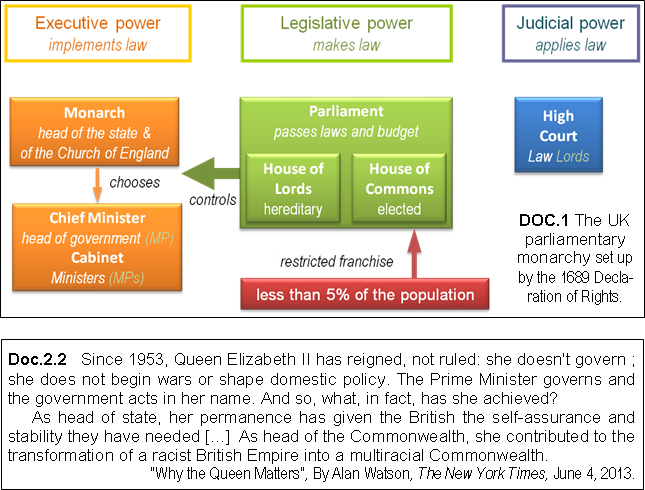& THE RULE OF LAW
| POLITICAL POWERS & THE RULE OF LAW |
Method: Commenting on 2 documents
GUIDELINE: The evolution of British monarchy

Stage 1: Introduction - Presenting the documents
Say what the docs have in common, usually the topic (in the guideline) and the context (but not here).
+ Define notion(s) in the guideline, the title (here "monarchy" in the guideline).
Both documents describe the evolution of the British monarchy, that is to say a political regime with a hereditary head of state, a monarch.
Give the differences between the docs, rephrase the references of each document.
The first document is a diagram showing UK parliamentary monarchy as it was set up by the Declaration of Rights in 1689 whereas the second document is an article by Jon Stone from BBC News published on 13 July 2016 about David Cameron's resignation.
Give the structure, usually one part for each document (use the guideline and/or the topic of each document).
In a first part, we are going to see, to analyse the British monarchy at its beginning in 1689 thanks to/with the 1st document and in a second part I will show how it adapted, how it evolved using the 2nd document.
Stage 2: Analysing the documents
Analyzing a text.
• Analyse the text paragraph by paragraph to follow its logic.
• Give a title (= the main idea) to each paragraph.
• Rephrase what each paragrapoh says with synonyms to show you understand what it means.
| DESCRIBE THE DOCS What you see (=DOCS) |
INTERPRET THE DOCS What you know (=NOTIONS) |
PART 1. Firstly, the diagram shows the British monarchy in 1689 |
|
| The 3 powers : - the executive power is held by ... (describe what you see on the diagram) - the legislative power is held by ... (describe what you see on the diagram) - the judicial power is held by ... (describe what you see on the diagram) + Election : less than 5% of the population elect the House of Commons, it's a restricted franchise |
=> Notion 1 : the separation of powers =... give the full definition given in the Recap I.2. |
| PART 2. Secondly, the article explains the role of the Queen today | |
| P1 (title) The Queen has no real power -(Rephrasing) Elizabeth II reigns but doesn't govern : she doesn't decide foreign or domestic policy, the PM & government do it for her. P2 (main idea) However, she has a major role -(Structure & rephrase) In the UK : she symbolises unity & stability. -(Structure & rephrase) In the Commonwealth : she promoted equality and diversity. |
=> Notion 7 : a powerless Queen. Use what was said in the 1st paragraphs of Recap II.2. The Queen's role => Notion 8 : but a major symbol. Use what was said in the last paragraph of Recap II.2. The Queen's role |
Stage 3: Concluding
Assess the documents, say if the documents are reliable or not and biased or not without forgetting to justify your choice.
To conclude, the diagram is reliable because it represents the UK constitution. It's unbiased as it just gives the facts. The article is reliable too as we have its full references and the New York Times is a quality US newspaper, it's also unbiased because the journalist gives facts without any opinion.
Sum-up the main ideas, recap what the 2 documents showed you.
To recap, these 2 documents show how the British parliamentary monarchy changed since 1689 with the monarch evolving from a real power to a strong symbol.
+ Opening, open on a related topic you are interested in / you know a lot about, to prompt the examiner into asking you questions on this particular topic.
We explained how the British monarchy evolved, what about the US republic ?
We may wonder how the role and power of the US president evolved.